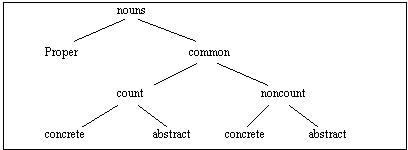
Nouns
Definition:
- A very common definition of a noun is to say that it is a word to name a person, place, thing or idea. So uncle, London, tree and confusion would be examples of nouns fulfilling this definition.
- However, in modern linguistics it is thought to be more helpful to think of the noun in terms of its syntactical function in the sentence. So a noun can be described as being likely to exhibit one or more of the following features:
- They can have a plural form: table/tables; tree/trees (but not London/Londons)
- They can be the subject of a sentence: The tree had fallen across the road.
- They can be at the head of a noun phrase: my kind,eccentric uncle.
- There are also several suffixes which indicate that a word is a noun:
-ity electricity; community -ant celebrant; participant -ism racism; feminism -tion destination; communication -ling duckling; foundling -ship friendship; fellowship -hood brotherhood; boyhood
Very often the suffix used to form the noun can indicate whether it is a concrete or an abstract noun. The suffixes -age, -ism, -ship, -ity, and -ment, for example, usually form abstract nouns (suffrage; racism; companionship; cupidity; astonishment). Other suffixes, such as -ess, -er, -let, and -ant usually form concrete nouns (hostess; commoner; froglet; participant).
Types of Noun:
Traditional categorisation of nouns as proper, common, collective and abstract are now considered to be too vague and instead the noun is sub-classified more precisely.

Proper and common nouns:
- This initial sub-division of nouns simply distinguishes between the names of specific people, places, titles, events and so on and the more generic descriptions of people, places and things.
Look at the table and think what common noun might go in each of the boxes marked with a question mark.
Proper Debra Poole Canada Dartmoor Titanic Twix Astra 'Emma' Common woman town country moor ? ? ? ?
- A further feature of Proper nouns is that they do not usually have a plural form (Debras, Pooles, Canadas) and are not usually used with a determiner (the Poole; a Canada). And, of course, Proper nouns begin with a capital letter.
- Did you complete the boxes with question marks?
- you might have chosen common nouns such as: ship; chocolate, car.
Count and noncount nouns:
- All common nouns can be sub-divided into either count or noncount nouns. Count nouns are those which do have a plural (tree/trees; soldier/soldiers; cake/cakes). These nouns have a specific countable reference whereas noncount nouns name notions or masses such as goodness, music or horticulture. These words cannot form a plural, except in rare circumstances, and can also stand as the subject in a sentence without a determiner. Count nouns cannot stand alone as the subject in the singular.
Goodness is a virtue to be admired. 
But Tree is very tall. 
Concrete and abstract nouns:
- Both count and noncount nouns can be subdivided into concrete and abstract nouns. Concrete nouns are those which have measurable or observable referents, such as table or rain, whereas abstract nouns refer to ideas, emotions and concepts, such as thought, fear and determination.
- Although in many instances the distinction between the observable, quantifiable nature of concrete nouns and the abstracted, conceptualised quality of abstract nouns is easy to see, it is important to be aware that very often the distinction is less clear. Often expert grammarians will argue about whether a given noun is concrete or abstract. In the sentence, England has an outstanding national football team, it is debatable whether the noun 'team' is concrete because it refers very specifically to a team of identifiable players or abstract because it refers to the notion of a group of people working collectively together.
Compound nouns:
- Compound nouns are nouns which are built up by combining two or more words into a single unit. In terms of language development, this is a common way of coining words for new ideas or inventions.
- Compound nouns often take the form of a single word, composed of two nouns put together: as in football, sunlight, bedroom, bookcase. Sometimes, however, it is a more complex construction, such as father-in-law or right-of-way.
- Historically, many compound nouns were used first as two separate nouns, eg book case but frequent usage has made the two words into one. When compounds are coined, a hyphen is often used to indicate the coinage (eg micro-computer) but as the word becomes more familiar the hyphen is usually dropped (eg microcomputer).
- Some compound nouns, however, remain as two words, but act syntactically as a single unit. This is particularly true of Proper nouns describing places or titles, such as the Albert Hall, Alton Towers, Great Windsor Park or the Education Secretary. Common nouns can be compound nouns, too, where two nouns are almost always used together eg parking meter; tree surgeon, window cleaner. Compound nouns like these cannot be separated by other words: you could say the 'the imposing Albert Hall' but you could not say 'the Albert imposing Hall'. In addition, the stress in a compound noun is on the first word. This helps to distinguish these compound nouns from any other premodified nouns.
- There are phrases in English which link two nouns together with 'and', which regularly occur together, and in which the word order is fixed. Common examples are health and safety, principles and practice, art and craft. These are also compound nouns.



You are currently here: Word Classes > Nouns. The next page in this section is Advanced Nouns.